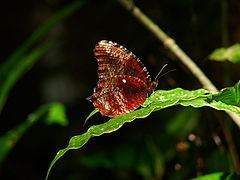Kingdom Animalia Order Lepidoptera Family Nymphalidae Scientific name Elymniini Rank Tribe | Phylum Arthropoda Superfamily Papilionoidea Subfamily Satyrinae Higher classification Satyrinae | |
 | ||
Similar Nymphalidae, Satyrinae, Butterflies and moths, Butterfly, Kirinia | ||
The Elymniini (true browns) are one of the large tribes of the browns subfamily (Satyrinae) in the brush-footed butterfly family (Nymphalidae). Sometimes, they are elevated to subfamily status as Elymniinae.
Contents
Systematics
They are commonly subdivided into four subtribes (tribes when considered a subfamily). The largest tribe is called Lethina, with Parargina usually treated as a junior synonym. But this is not correct as it seems: according to cladistic analysis of mtDNA COI and NADH dehydrogenase subunit 1 sequence data, the Parargina – i.e. the group around Pararge, including at least the very similar Lasiommata as well as Tatinga and it is the doubtfully distinct relative Chonala – form a distinct lineage after all, immediately basal to the distinctly apomorphic Mycalesina and the more plesiomorphic Lethina proper; the accurate circumscription of these subtribes remains yet undetermined. In any case, these three constitute the bulk of the tribe's diversity. The Elymniina and Zetherina, by contrast, quite certainly form a less diverse clade that diverged early on in the evolution of the tribe.
Selected genera
Subtribes are listed in the presumed phylogenetic sequence, from the most ancient to the most advanced; genera are listed alphabetically. Some species are also listed.
Subtribe Elymniina
Subtribe Zetherina
Subtribe Lethina (including Parargina, but paraphyletic)
Subtribe Mycalesina
Fossil record
Several prehistoric genera have been described from fossils:
They are usually all assumed to belong to the Lethina; due to the non-monophyly of that group, all that can be said is that they are probably fairly basal members of the more diverse radiation. Fossils from near the time of such divergences often yield interesting insight into the patterns of evolution.
